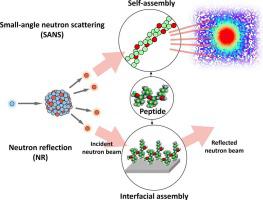Advances in Colloid and Interface Science ( IF 15.9 ) Pub Date : 2023-10-21 , DOI: 10.1016/j.cis.2023.103033
Xuzhi Hu 1 , Mingrui Liao 2 , Ke Ding 2 , Jiqian Wang 3 , Hai Xu 3 , Kai Tao 4 , Feng Zhou 5 , Jian R Lu 6

|
Self-assemblies of de novo designed short peptides at interface and in bulk solution provide potential platforms for developing applications in many medical and technological areas. However, characterising how bioinspired supramolecular nanostructures evolve with dynamic self-assembling processes and respond to different stimuli remains challenging. Neutron scattering technologies including small angle neutron scattering (SANS) and neutron reflection (NR) can be advantageous and complementary to other state-of-the-art techniques in tracing structural changes under different conditions. With more neutron sources now available, SANS and NR are becoming increasingly popular in studying self-assembling processes of diverse peptide and protein systems, but the difficulty in experimental manipulation and data analysis can deter beginners. This review will introduce the basic theory, general experimental setup and data analysis of SANS and NR, followed by provision of their applications in characterising interfacial and solution self-assemblies of representative peptides and proteins. SANS and NR are remarkably effective in determining the morphological features self-assembled short peptides, especially size and shape transitions as a result of either sequence changes or in response to environmental stimuli, demonstrating the unique capability of NR and SANS in unravelling the interactive processes. These examples highlight the potential of NR and SANS in supporting the development of novel short peptides and proteins as biopharmaceutical candidates in the fight against many diseases and infections that share common features of membrane interactive processes.
中文翻译:

表征肽组装体中的中子反射和散射
从头设计的短肽在界面和散装溶液中的自组装为许多医疗和技术领域的应用开发提供了潜在的平台。然而,表征仿生超分子纳米结构如何随着动态自组装过程演化以及对不同刺激的响应仍然具有挑战性。包括小角中子散射(SANS)和中子反射(NR)在内的中子散射技术在追踪不同条件下的结构变化方面可以是有利的,并且可以与其他最先进的技术相补充。随着现在有更多的中子源可用,SANS 和 NR 在研究不同肽和蛋白质系统的自组装过程中变得越来越流行,但实验操作和数据分析的困难可能会阻止初学者。本综述将介绍 SANS 和 NR 的基本理论、一般实验设置和数据分析,然后提供它们在表征代表性肽和蛋白质的界面和溶液自组装方面的应用。 SANS 和 NR 在确定自组装短肽的形态特征方面非常有效,特别是由于序列变化或响应环境刺激而导致的尺寸和形状转变,这证明了 NR 和 SANS 在阐明相互作用过程方面的独特能力。这些例子凸显了 NR 和 SANS 在支持开发新型短肽和蛋白质作为生物制药候选物方面的潜力,以对抗许多具有膜相互作用过程共同特征的疾病和感染。







































 京公网安备 11010802027423号
京公网安备 11010802027423号